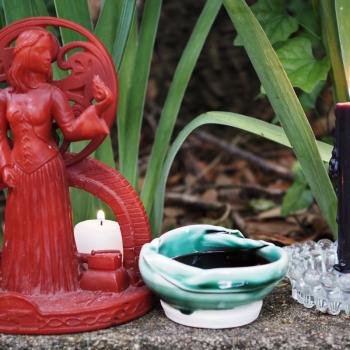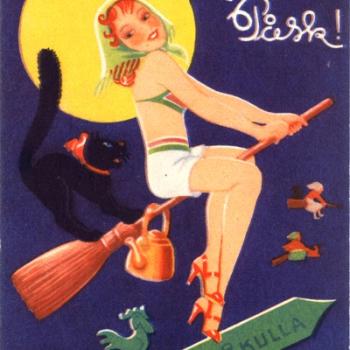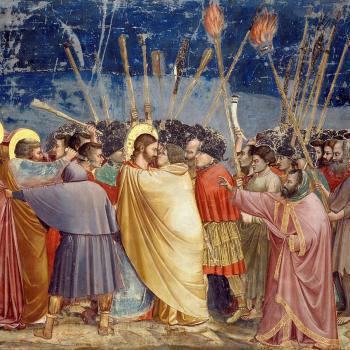Fýr, fleax, fódder, frið
(Fire, Flax, Fodder & Frith)

Since the private letters of Robert Cochrane became discretely distributed throughout the witchcraft communities, and amongst those pagans who picked up titbits here and there, there has been a saying that has flourished. Described as an Anglo-Saxon blessing, Cochrane signed his letters to American founder of the 1734 Tradition, Joe Wilson, in the 1960s with the letters fff, signifying, he says, ‘flags, flax and fodder’, or a home, clothing and food: the three necessities of life to the ancient mind. This small benediction, attributed to the Anglo-Saxons according to Cochrane, sometimes included the fourth and final f, signifying, we are told, ‘frig’. This latter is supposedly an allusion to the Norse deity Frigga, as well as possessing its early-modern connotation as a sexual euphemism, dating to around 1550s CE1.
Modern Traditional Witchcraft interpretations including allusion to Fate or the Fates in this signature, which has also been adopted by those who practice or otherwise adhere to ‘Northern Traditions’ and ‘Asatrua’, clearly finding resonance with its seemingly old Teutonic relevance.
My first encounter with the now famous fff occurred as an avid reader of the classic 2000AD comic series, Sláine, which (in my humble opinion) peaked with the ‘Horned God’ serial which ran between 1989-1990 and was published as a whole with an introduction from Caitlin Matthews (1993). In one of the comics, a reference to the essentials of life is made, except this time it is fire, fodder and frig, somewhere for warmth and to cook food, something to eat, sustenance, and a way to sate the sexual drive. Unfortunately, this repeats the frig aspect which, as we have seen, originates in the early-modern era, becoming synonymous with masturbation (usually female) as early as the seventeenth century.
Similarly, flags is absent in the rendition repeated in the Sláine comics. Like frig, the word flag to denote a paving stone, or flat, stone really only dates to the 16th Century in the English tongue. Although likely descending from the Old Norse flaga2, it still maintains a meaning from a cut of sod, to a flat paving stone. Very little suggests the meaning, or indeed etymology, which Cochrane believes in his letter to Wilson that flag refers to the foundation stones of a dwelling and, thereby, signifies a ‘house’ or ‘home’.

In addition to the omissions, the element of fire as been included which, given the significance of this most hoary invention upon human psyche and evolution, would seem pertinent. Indeed, so central was fire to early civilisations for whom its mechanical creation was an apparent act of magic, no easy feat, that the Romans entrusted the Vestal Virgins in the temple of Hertha with the maintaining of the sacred fire, which was kindled every year from the embers of the previous year’s, thus ensuring its continuance. This state sponsored hearth fire was the religious heart of the Roman culture and survived into the Christian era before being forcibly closed in 391 CE. Mirroring the sacred fires of the Temple of Vesta in Rome, the modern rendition of the Yule fire harkens to a mythical Norse log which perhaps symbolises the very real need for families to maintain the hearth fire in the dead of winter. The carrying and passing of flame, which signifies the continuance of that sacred fire, lineage and tradition, is echoed in the Olympic flame which is still used today. Similarly, the symbolism of the passing through the fire of the blood, the flame of tradition, is represented in witch families and clans as well as the ‘apostolic succession’ of the Christian clergy whereby a ‘golden chain’ continues the lineage of Christ from his earliest disciples to the present priests.
Finally, if we are placing a question mark over the inclusion of frig, then what word in Anglo-Saxon might have been mis-read or misunderstood in reading? There is one which makes perfect sense and would be included in a blessing or benediction, a thing that you might wish for another in benediction.
Frið is an Anglo-Saxon word which would be in use along with fire, flax and fodder. The significance of the word, which denotes not merely peace, but incorporates a balanced social, cultural and state condition whereby all are permitted to flourish harmoniously and upholding fealty to the head tribesman and the clan as a whole. It is the very sustenance of the status quo, including law and justice, honour, social relationships, societal mores and behaviour, as well as a condition or state of ‘peace’. In many ways, this word signifies so much in terms of Anglo-Saxon society and culture. In its most simple, it denotes friends and family, good relations. In a more nuanced interpretation, it indicates a harmonious clan through a ‘peace’ maintained through social interaction, ideas of justice, fate, nature, hierarchy and luck.

The letter thorn, often indicated by, and synonymous with, the letter eth ð, capitalised as Ð . These two letters have been lost in the English alphabet, yet their phonetic sound remains as the sound th. Interestingly, the word frith became obselete in the English language by the 16th century, coinciding with the emergence of the word frig, euphemistically, and crudely, inferring sex, as in ‘to fuck’. Many modern words replaced the old letters that remained from Anglo-Saxon and Norse alphabets, sometimes replacing the sound with either th or d for the letter thorn. However, at a glance, we could see how somebody might mistake frið for frig, perhaps with a wry and puerile snigger.
In this brief discourse, some renditions of the common blessing, written in shorthand as fff, have been explored. There is a world of hidden depth, especially when you consider the letters as a repetition of the sixth letter of the alphabet, therefore being rendered in English numerology as 666, from the Book of Revelation written by John of Patmos.
Many people have associated the fs with the elements or airts in a compass, which is interesting when placed in a pattern as below. This arrangement provides a central square formed from the arms, or friðgeard (a sacred enclosure, or sanctuary, for the worship of the Gods) and also a fylfot3 cross. Each arm of the cross ends like a crozier at each of the four airts, or winds, of the compass.
- https://www.etymonline.com/word/frig#etymonline_v_14181
- https://www.etymonline.com/word/flag
- Originating, perhaps, in the AS for ‘four-footed’…



















